|
The fishing folks I envy most don't transport their
boat to a lake, pond or river every trip � the boat
is already there. But for me and most others who
fish out of boats, we need a way to get it from home
to wherever we're fishing, and then back again.
Every trip.
A number of people have emailed me asking how I
transport my canoe. This being wintertime and my
local waters getting iced over, now seems a good
time to write something on this subject. At worst,
this article will give readers an idea of what they
don't want to do. At best, it will give some basic
information on rack systems that have worked well
for me. Unfortunately, I have no photos of the first
three racks I used.
The first rack was a "Quick & Easy" outfit. Four
mounts clamped solidly onto the raised rain gutters
on my 1972 Plymouth Duster 2-Dr. The crossbars were
a pair of common steel pipes, each pipe outfitted with
clamp-down gunwale holders that pinned my Grumman
Standard 17-ft. tandem canoe in place.
After buying a 1984 Toyota Tercel 4-dr hatchback,
I cannibalized the Quick & Easy rack so that I
could employ its rain gutter mounts on the Tercel.
I dispensed with the steel pipe crossbars in favor
of pressure-treated 2x4s and bolted those to the
Quick & Easy gutter mounts. After that task was
completed I added custom-fitted homemade gunwale
stops that held my inverted canoe in place. (But
the brackets fit only that specific canoe; no other
canoe could ride in this unique "cradle.") Last,
I carpeted the 2x4 crossbars to reduce abrasion on
the canoe's beautiful wooden gunwales while
loading/unloading. This carpeting was accomplished
by custom-cutting strips of common indoor/outdoor
carpet then gluing the pieces to the top surface
of the 2x4 crossbars using Weldwood cement.
With both of these first two racks I had very little
confidence in the holding power of the gunwale
brackets/braces. This meant tying down the bow
and stern of the canoe every trip, using security
lines attached to my bumpers. Lots of line, lots
of knots; I really enjoyed fussing with the knots.
Personally, I'd have been happy if auto manufacturers
had NEVER stopped building vehicles with raised rain
gutters. Those gutters were extremely handy as
clamp-down points for canoe racks like Thule, Yakima
and the Quick & Easy. But styles change; in what seemed
like only five years time raised rain gutter disappeared
and were succeeded by aircraft door-style rain gutters.
This style change by automakers forced canoe rack
manufacturers to re-design their rooftop connection
hardware.
Around this time, in 1992, I bought a Ford Explorer.
My first SUV, it and had a much longer roofline than
the compact passenger cars I'd owned previously. I
factory ordered my Explorer without the standard luggage
rack, a rack I knew was useless -- even dangerous -- for
use as a canoe carrying platform.
The Explorer had the new-style aircraft door rain
gutters, which forced my customized Quick & Easy
canoe rack into retirement. In its place I bought
a Yakima crossbar set.
My personal preference in any canoe rack is to have
the two crossbars be long enough that I can carry a
pair of canoes side-by-side. Also, I want the two
crossbars to be located the maximum possible distance
apart. (The farther apart the crossbars, the less apt
the canoe is to move about on the rack when hit by
sudden gusts of wind while your vehicle is underway
at highway velocity.)
With rack systems like Thule and Yakima, the only
way to connect the mounts to a modern vehicle's rain
gutters is by purchasing molded steel plates that fit
the unique door shape of the vehicle you own. Okay,
but in my case I was not satisfied with this idea
because an Explorer's front doors and rear doors are
not spaced far enough apart to achieve the tie-down
separation distance I prefer for maximum boat carrying
security.
Luckily for me, Yakima designers anticipated this.
The company sells 'artificial rain gutters' called
Bolt Top Loaders. I bought a pair of these plates
for my rear crossbar and installed the plates directly
onto my roof near the rear hatch. The job required
pulling down the interior headliner so I could visually
find the safest spot to drill holes in the metal roof.
(Not a good idea, drilling blindly and severing your
tail light/brake light/turn signal wiring harness.)
There are few things more nerve-racking than glancing
over and seeing your wife standing like a trigger-happy
prison guard while you drill four permanent holes through
the gleaming roof of a $20,000 SUV so new it still has
its factory stickers in the rear window. I was scared
out of my wits, but determined. See, prior to buying
this SUV I'd made it crystal clear that I would not
co-sign my name to the purchase order unless she promised
that I could custom-install this canoe rack on the vehicle.
No Yakima rackee, no Ford truckee.
I have no photos of the Yakima rack that I put on the
Explorer. But to give you an idea of its stability,
the two crossbars were 9 feet apart. That spread
resulted in a super-secure carry for my boats and
my friends boats for ten wonderful canoe trip-filled
years.
With such a long tiedown spread, I quickly relaxed
to the reality that it was no longer necessary under
normal circumstances to run a bow and stern dropline
from the canoe ends down to my front and rear bumpers.
Only in the most severe high winds would I now connect
droplines.
Also, around the time I bought and outfitted this Ford
Explorer I made the transition from homemade boat
tiedown ropes to Northwest River Supply (NRS) 12-ft.
tiedown straps. NRS straps have a cam lock buckle
that is secure under all circumstances provided the
cam spring is in good working order. (I do have one
15-year old NRS strap whose buckle spring weakened).
So much for my first three racks.
My fourth canoe rack was one I bought after June Newman,
one of my canoeing friends, installed one on her Ford
Ranger pickup. I was so impressed that it motivated
me to replace my aging Ford Explorer with a Ford Ranger
then install the same rack system June had. I've never
regretted either purchase.
Pictured below (and not pictured that well, sorry) is
this Oak Orchard rack system as it appears on the Ranger.
(The Ranger now belongs to my son, Eric, who mountain
bikes more often than he canoes, but he wanted racks
for times when he does canoe.)
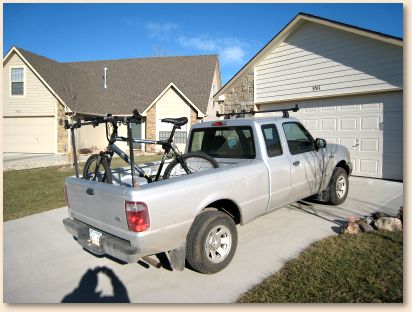
This particular rack system is the Pickup Truck Rear
Rack, Deluxe #1 Style made by Oak Orchard, a company
located in Rochester, New York. (You can find them
on the Web.) The design of the rear rack mount is
minimalist but incredibly strong. At first glance
the slender square-tube upright supports appears
flimsy. In truth, once you put a canoe on this rack
it rides like it's set in concrete. Grab your canoe
and shake it: the truck moves, the canoe does not.
One reason being that the tiedown spread (the distance
from cab roof crossbar to tailgate crossbar) is some
9 feet, which combined with the crossbar-mounted gunwale
brackets and NRS straps does not allow any rattling or
lateral movement by the canoe whatsoever.
In the photo below you can see one of the custom-fit
rain gutter door clips that Yakima makes for grabbing
hold of today's aircraft style rain gutters (in this
case a 2002 Ford Ranger). It is necessary to buy the
gutter plates specifically designed for your vehicle's
doors. Substitutes won't do.
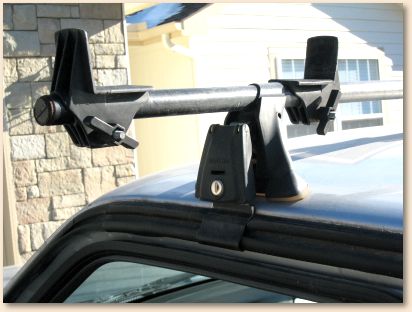
The next photo (below) shows one of the vertical square-tube
steel support posts. The base of this post comes with drill
holes already made. The rear crossbar support posts are
bolted to the inside surface of your truck's tailgate area,
at a point just inside the tailgate itself.
This particular model of the Oak Orchard rack is
designed for use with an open truck bed, which is
what many canoeists and kayakers go with. I love
the simplicity and strength of this design, although
on long canoe trips I always had concerns about the
theft of gear during rest stops at restaurants and
such. Still, the convenience of having an open pickup
bed cannot be dismissed for those who like their canoe
trips to involve rapid loading/unloading of gear from
both sides of the truck bed.
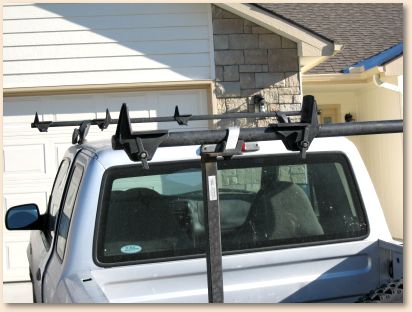
Now for the canoe rack setup I have now:
In 2004 I bought a Toyota Tacoma 2x4 pickup.
Initially what I did was remove the Ford Ranger's
Oak Orchard rack and transfer it to my Tacoma.
This task involved drilling new mounting holes
on my Tacoma's tailgate area in order to install
the "nutserts" that hold the rear crossbar support
uprights in place. Also there was a modest purchase
of two door clips to fit the Tacoma's cab door rain
gutters.
But when my son, Eric, expressed a desire for canoe
racks for his pickup so that he could go with me on
trips (or shuttle other boaters), I moved the entire
Oak Orchard rack setup from the Tacoma back onto his
Ranger.
Once I had the Tacoma, and soon after getting divorced,
I decided to buy a "cab high" fiberglass shell for my
pickup bed. This shell would multi-task, providing
hard shelter for my music, canoeing and fishing gear.
Also, the interior of the shell offered a large enough
space that I outfitted and stocked the shell in such a
way as to convert it into a high-tech "micro-apartment."
I lived in this shell, quite snugly and inexpensively,
for 14 months until just recently, and will not hesitate
to move back into it if the need arises.
The Astro shell I bought for my Tacoma pickup did,
however, rule out using an Oak Orchard rear rack
system. I could still employ a Yakima rack system,
though. What I did was use the same type of Bolt
Top Loader plates that I'd installed years earlier
on the roof of my old Ford Explorer. Except now
instead of drilling through a sheet metal roof I
drilled through the roof of a fiberglass shell.
The installation proved trickier than I'd anticipated
due to subtle curvature of the shell's roof making it
hard to find flat attachment points in the area I wanted
the top loader plates to sit.
Below are a couple of photos that show one of my
rear crossbar mounts sitting on a Bolt Top Loader
plate. The crossbar mount locks onto the plate
in the same fashion it would clamp onto an old-style
external rain gutter.
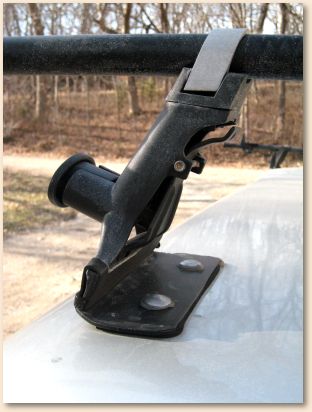
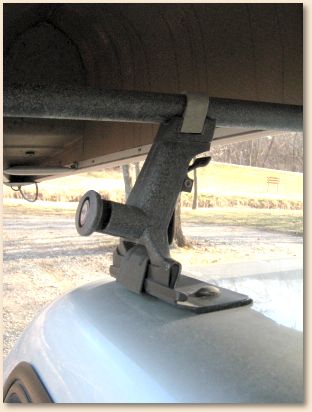
Next, a closeup photo of one of the Yakima door clips.
These clips are shaped specific to fit the Toyota
Tacoma's aircraft style rain gutters. The door clips
secure the front crossbar mount to the roof of my truck
cab. Close the cab door and the clip can't come off
(the secret to the system's strength).
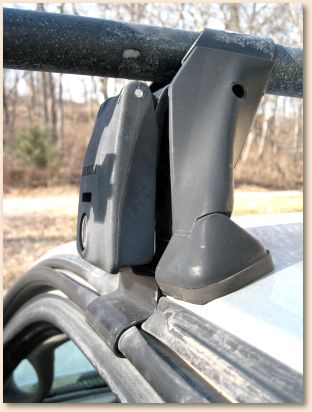
Now for the matter of securing the boat on the rack:
You don't want your canoe bouncing up and down on the
rack crossbars. Nor do you want the canoe yawing left
and right. You don't want that canoe to move, not the
slightest bit. Yakima (and other rack makers) devise
gunwale brackets that must be purchased separately then
attached to the crossbars. They come in sets of four,
and once installed on the bars the brackets can be moved
independently into almost any position along the length
of the bar.
The adaptability of the gunwale brackets lets you put
the canoe on the rack (inverted), line up the boat the
way you prefer, then move the four brackets underneath
the gunwales and tighten them down. This results in a
"cradle" into which you lay your canoe prior to strapping
it down. And Mama, this cradle don't rock. You put your
canoe into it, strap it down tightly, and your pickup
could be turned upside down and shaken and that canoe
won't come off. Just make sure all related mount,
crossbar, gunwale bracket, and strap fittings are
tight and secure.
Below are some closeup photos of my canoe on the rack,
strapped and ready for travel.
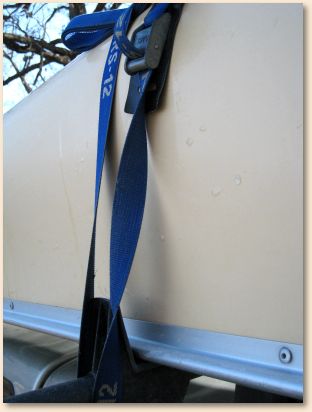
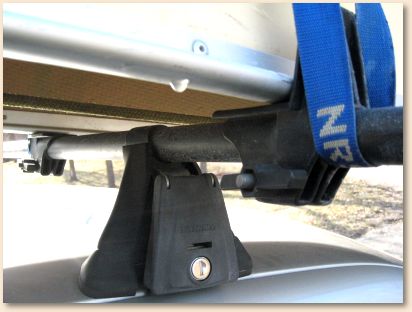
The observant reader will notice that on the forward
side of the cab crossbar the NRS strap has a full
twist, while on the aft side of that same crossbar
the strap is flat. This is a trick I use to keep
the straps from humming loudly at highway speed.
If you don't give the forward half of the strap
this full twist, the wind blows across it and makes
it vibrate like the reed in a duck call. But giving
the forward half of the strap a full twist before
cam-locking it, this creates a "spoiler" that disrupts
the airflow over the trailing half of the strap. The
result? No highway hum gets generated by the tightened
down straps.
Next, here's a photo of my Wenonah Rendezvous solo canoe
strapped onto my Tacoma's Yakima rack system. Canoe and
pickup are ready for the road.
An inverted canoe thus held causes very little wind
resistance, which is important because such minuscule
wind resistance does not reduce your vehicle's fuel
efficiency. On the highway your canoe cuts through
the air like a knife.
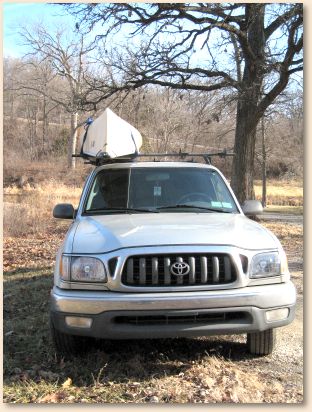
Last, here's a front angle photo of my Tacoma with
the Wenonah solo on one half of the rack, and an
empty spot next to it. A second set of gunwale
brackets has been attached to the crossbars,
preparations for a second canoe. I am a firm believer
in people buying canoe rack crossbars that are at least
66 inches long. This allows a second boat to be carried,
which is most important when doing canoe shuttles on river
trips.
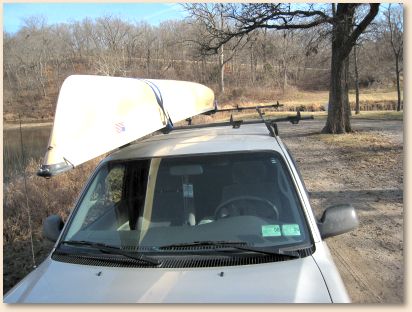
Hope this story and these photos give you some ideas
on how you can rack and transport your canoe or kayak
if you are thinking about taking up the sport of fly
fishing using a self-propelled watercraft as your
mobile operating platform.
About Joe:
 From Douglas County, Kansas, Joe is a former municipal and
federal police officer. In addition to fishing, he hunts
upland birds and waterfowl, and for the last 15 years
has pursued the sport of solo canoeing. On the nearby
Kansas River he has now logged nearly 5,000 river miles
while doing some 400 wilderness style canoe camping
trips. A musician/singer/songwriter as well, Joe's
'day job' is with the U.S. General Services Adminstration.
From Douglas County, Kansas, Joe is a former municipal and
federal police officer. In addition to fishing, he hunts
upland birds and waterfowl, and for the last 15 years
has pursued the sport of solo canoeing. On the nearby
Kansas River he has now logged nearly 5,000 river miles
while doing some 400 wilderness style canoe camping
trips. A musician/singer/songwriter as well, Joe's
'day job' is with the U.S. General Services Adminstration.
Joe at one time was a freelance photojournalist who wrote the
Sunday Outdoors column for his city newspaper. Outdoor
sports, writing and music have never earned him any money,
but remain priceless activities essential to surviving the
'day job.'
|











 From Douglas County, Kansas, Joe is a former municipal and
federal police officer. In addition to fishing, he hunts
upland birds and waterfowl, and for the last 15 years
has pursued the sport of solo canoeing. On the nearby
Kansas River he has now logged nearly 5,000 river miles
while doing some 400 wilderness style canoe camping
trips. A musician/singer/songwriter as well, Joe's
'day job' is with the U.S. General Services Adminstration.
From Douglas County, Kansas, Joe is a former municipal and
federal police officer. In addition to fishing, he hunts
upland birds and waterfowl, and for the last 15 years
has pursued the sport of solo canoeing. On the nearby
Kansas River he has now logged nearly 5,000 river miles
while doing some 400 wilderness style canoe camping
trips. A musician/singer/songwriter as well, Joe's
'day job' is with the U.S. General Services Adminstration.